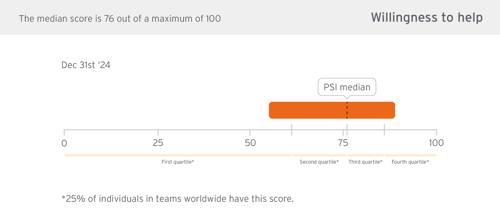Why Willingness to Help Matters
When people think about high-performing teams, they often focus on individual talent. But time and again, research shows that what sets successful teams apart is not how smart their members are, but how well they work together. One of the clearest signals of this is Willingness to Help.
Willingness to Help means that people are not just willing, but eager, to support their colleagues. It shows up when someone offers assistance before being asked, shares their time and expertise freely, and makes others' success a priority. On psychologically safe teams, helping is not viewed as a distraction. It’s part of the job.
When this domain scores high, teams tend to be more resilient, more innovative, and more productive. When it scores low, people often feel isolated, overwhelmed, or undervalued.
What the Score Means
In the Psychological Safety Index, the Willingness to Help domain reflects whether people feel supported by their teammates and whether they themselves are encouraged to contribute.
A high score indicates that:
-
People regularly offer help to one another
-
Team members feel comfortable asking for support
-
Helping behaviors are recognized and valued
A low score may indicate:
-
A culture of individualism or competition
-
Lack of trust between team members
-
People feel that asking for help is a sign of weakness
Global Benchmarks

Based on data from hundreds of teams around the world, the average global benchmark for Willingness to Help tends to be relatively high. This is often the strongest domain across teams, because offering help is a behavior that many people value and feel comfortable demonstrating.
However, even teams with strong scores in this area can benefit from unpacking what’s behind them. Is help offered selectively? Are some people more likely to receive help than others? Do structural or cultural issues make helping harder than it needs to be?
Key Mindsets and Behaviors
Improving Willingness to Help starts with the belief that collaboration is more effective than individual heroics. Leaders and team members can cultivate this domain through both mindset and practice.
Mindsets to adopt:
-
"We succeed together or not at all"
-
"Asking for help is a sign of strength, not weakness"
-
"My time is valuable, and so is yours"
Helpful behaviors include:
-
Actively checking in with teammates to see what support they need
-
Recognizing and celebrating helping behaviors in meetings or team channels
-
Modeling vulnerability by asking for help as a leader
Red Flags to Watch For
If your team score in the Willingness to Help domain is low, or if you hear some of the following patterns in conversation, it may be time to explore the topic more deeply.
Common red flags include:
-
"Everyone is too busy to help"
-
"I don’t want to bother anyone"
-
"If I help someone, I’ll fall behind"
-
Team members working in silos with little cross-functional collaboration
These cues often signal deeper issues with trust, workload, or team norms that discourage mutual support.
Practical Steps to Improve This Domain
If your team wants to strengthen the Willingness to Help domain, try introducing some of the following practices:
1. Make helping visible
Create a space, such as a dedicated Slack channel or time in a meeting, to acknowledge when team members go above and beyond to support each other.
2. Normalize asking for help
Leaders can set the tone by openly asking for input, support, or feedback. The more it's modeled, the more it becomes a safe and accepted behavior.
3. Use structured peer support
Consider setting up short peer coaching sessions or pairing team members for regular check-ins where asking for and offering help is expected.
4. Protect time to help
If your culture rewards constant output and overwork, people may feel there’s no time to be generous. Help your team set boundaries and protect time for collaboration.
Wondering how your team measures up in their Willingness to Help?
We offer a simple and effective team assessment tool that provides anonymous insights into your team's psychological safety levels. Both an overall score as in the four domains. This invaluable assessment is the first step towards unlocking your team's full potential.



